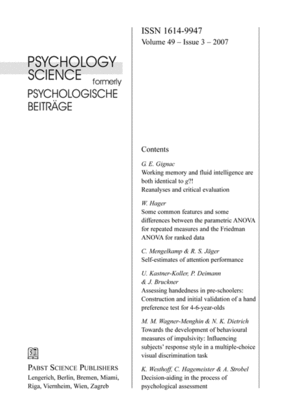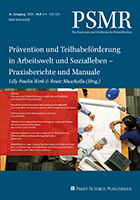Contents, Volume 49, 2007, Issue 3
GILLES E. GIGNAC
Working memory and fluid intelligence are both identical to g?! Reanalyses and critical evaluation
Abstract |  PDF of the full article
PDF of the full article
WILLI HAGER
Some common features and some differences between the parametric ANOVA for repeated measures and the Friedman ANOVA for ranked data
Abstract | ![]() PDF of the full article
PDF of the full article
CHRISTOPH MENGELKAMP & REINHOLD S. JÄGER
Self-estimates of attention performance
Abstract | ![]() PDF of the full article
PDF of the full article
URSULA KASTNER-KOLLER, PIA DEIMANN & JOHANNA BRUCKNER
Assessing handedness in pre-schoolers: Construction and initial validation of a hand preference test for 4-6-year-olds
Abstract | ![]() PDF of the full article
PDF of the full article
MICHAELA M. WAGNER-MENGHIN & NICOLE K. DIETRICH
Towards the development of behavioural measures of impulsivity: Influencing subjects response style in a multiple-choice visual discrimination task
Abstract | ![]() PDF of the full article
PDF of the full article
KARL WESTHOFF, CARMEN HAGEMEISTER & ANJA STROBEL
Decision-aiding in the process of psychological assessment
Abstract | ![]() PDF of the full article
PDF of the full article
Working memory and fluid intelligence are both identical to g?! Reanalyses and critical evaluation
GILLES E. GIGNAC
Abstract
In this investigation, two previously published confirmatory factor analytic studies that separately reported working memory and fluid intelligence higher-order loadings so large as to suggest isomor-phism with g were evaluated critically within the context of internal consistency reliability. Specifi-cally, based on two data analytic approaches, the previously reported higher-order loadings which suggested isomorphism with g were demonstrated to have been achieved via the substantial disattenua-tion effects observed within structural equation modeling, when the latent variable corresponding composite scores are associated with low levels of reliability. The two approaches were: (1) the obverse of the disattenuation procedure for imperfect reliability, and (2) the implied correlation between a corresponding phantom composite variable and a higher-order g factor. The results derived from the two approaches were found to correspond very closely. To allow for a more informative evaluation, researchers are encouraged to report the internal consistency reliabilities associated with the composite scores which correspond to their latent variables, as well as to report both the disattenuated and attenu-ated higher-order loadings within their multi-factor models.
Key words: intelligence; higher-order modeling; reliability; working memory; fluid intelligence
Gilles E. Gignac
School of Psychology
University of Western Australia
35 Stirling Highway
Crawley, WA, 6009
Australia gilles@psy.uwa.edu.au
gilles@psy.uwa.edu.au
Some common features and some differences between the parametric ANOVA for repeated measures and the Friedman ANOVA for ranked data
WILLI HAGER
Abstract
Some relationships between the parametric ANOVA of repeated measures and its nonparametric counterpart, the ANOVA for ranks after Friedman, are discussed. The main reason for some marked differences between both procedures arises from the fact that the mean correlation between the experi-mental conditions, i.e. rB, can vary between the limits -1 ≤ rB ≤ +1 for the parametric ANOVA and usually is greater than zero - only if this is the case, precision is enhanced. In contrast, this correlation always is negative for the Friedman ANOVA and only depends on the number K of experimental condi-tions: rR,B = -1/(K - 1). - In addition, it is stressed that the nonparametric rank tests can be replaced by their parametric counterparts without risking divergent decisions about the statistical hypotheses being tested. The necessary formulae and the respective effect sizes are presented.
Key words: Parametric ANOVA for repeated measures and ANOVA for ranks after Friedman, para-metric tests and effect sizes for ranked data
Prof. Dr. Willi Hager
Georg-Elias-Müller-Institut für Psychologie
Goßlerstr. 14
37073 Göttingen
Germany![]() whager@uni-goettingen.de
whager@uni-goettingen.de
Self-estimates of attention performance
CHRISTOPH MENGELKAMP & REINHOLD S. JÄGER
Abstract
In research on self-estimated IQ, gender differences are often found. The present study investigates whether these findings are true for self-estimation of attention, too. A sample of 100 female and 34 male students were asked to fill in the test of attention d2. After taking the test, the students estimated their results in comparison to their fellow students. The results show that the students underestimate their percent rank compared with the actual percent rank they achieved in the test, but estimate their rank order fairly accurately. Moreover, males estimate their performance distinctly higher than females do. This last result remains true even when the real test score is statistically controlled. The results are discussed with regard to research on positive illusions and gender stereotypes.
Key words: concentration, attention, gender, stereotypes, self-estimation
Christoph Mengelkamp
Reinhold S. Jäger
Centre for Educational Research
University of Koblenz-Landau
Bürgerstr. 23
76829 Landau
Germany![]() jaeger@zepf.uni-landau.de
jaeger@zepf.uni-landau.de
Assessing handedness in pre-schoolers: Construction and initial validation of a hand preference test for 4-6-year-olds
URSULA KASTNER-KOLLER, PIA DEIMANN & JOHANNA BRUCKNER
Abstract
The aim of this study was to develop and validate a test for measuring the handedness of pre-school children. The newly developed test consists of 14 activities for checking various aspects of hand preference and was administered to a Viennese sample of 120 children of the ages 4 to 6.5 (18 left-handed, 17 ambidextrous and 85 right-handed). For the purpose of validation, the handedness of the children was assessed via a questionnaire given to parents, observation of the hand used to draw and testing of visual-motor skills as well as general level of development using the Viennese Development Test (WET, Kastner-Koller & Deimann, 2002). The hand preference test proved to be reliable (α=0.97). The inter-correlations of the handedness measures gathered (parents estimate as well as observation of drawing hand) with the hand preference test substantiates the concurrent validity of the procedure. Right-handers exhibited the most pronounced hand preference; while the hand use of left-handers was significantly less lateralized. Irrespective of the direction of handedness, children with a consistent hand preference had higher total development scores than children with inconsistent use, i.e. frequent changes in hand used for a specific activity. Compared to ambidextrous and right-handed children, left-handers achieved significantly lower scores in the field of visual-motor skills. The results highlight the necessity of a reliable method for differentiated measurement of handedness as early as pre-school.
Key words: Handedness, pre-school age, hand preference test
Ursula Kastner-Koller
Department of Developmental Psychology and Psychological Assessment
Faculty of Psychology
University Vienna
Liebiggasse 5/1
1010 Vienna
Austria![]() ursula.kastner-koller@univie.ac.at
ursula.kastner-koller@univie.ac.at
Towards the development of behavioural measures of impulsivity: Influencing subjects response style in a multiple-choice visual discrimination task
MICHAELA M. WAGNER-MENGHIN & NICOLE K. DIETRICH
Abstract
In an attempt to reduce guessing during multiple-choice testing, the effects of different payoff matrices were observed in this research. It was hypothesized that a penalty for incorrect answers and the existence of the alternative "no decision have a significant effect on reducing guessing by subjects. Furthermore, this effect should become stronger the higher the risk of an incorrect response and therefore the higher the risk of losing points is. An experimental design with four different payoff matrices and a repeated measurement design with cross over (for the payoff for "no decision) was realized. A visual discrimination task including three steps (one power condition, two speed conditions), with each item containing three choices plus the "no decision option, was used. The results showed that the percentage of correct answers is influenced by the different payoff for the choice of "no decision. Only in groups where "no decision paid off with 0, was it chosen more often, however, the percentage for correct answers is lower in these groups. The results also indicate that subjects are able to adjust their behaviour according to the different payoff matrices.
Key words: Impulsivity, payoff, behavioural measure
Mag. Dr. Michaela Wagner-Menghin
Institut für Entwicklungspsychologie und Psychologische Diagnostik
Zimmer: O1.40
Liebiggasse 5
1010 Wien
Austria![]() michaela.wagner@univie.ac.at
michaela.wagner@univie.ac.at
Decision-aiding in the process of psychological assessment
KARL WESTHOFF, CARMEN HAGEMEISTER & ANJA STROBEL
Abstract
After some central statements on the assessment process, decision-aiding by Decision-oriented Assessment will be presented. Then rules for deciding about the clients question will be explained. After that the basis of every assessment is listed: the requirements and how to gather them. The behavioral equation of Decision-oriented Assessment will be introduced and its usefulness for the structuring of the assessment process will be shown. One further crucial phase of the assessment process is the selection of sources of information. - The basis of every sound psychological assessment is observation of behavior. Important parts of behavior can only be observed by the subjects themselves. Decision-oriented Interviewing enables assessors to gather these self-observations. The Instrument for the Description of Interviewer Competence in Proficiency Assessment (DIPA, Strobel, 2004) highlights the strengths and weaknesses of an interviewer when gathering self-observations from subjects. - Inevitably in the assessment process all pieces of information must be integrated so that, if agreed, well-founded recommendations can be derived.
Key words: Psychological assessment, decision-aiding, assessment process, task analysis
Prof. Dr. Karl Westhoff
Technische Universität Dresden
Institut für Psychologie II
01062 Dresden
Germany![]() karl.westhoff@tu-dresden.de
karl.westhoff@tu-dresden.de























